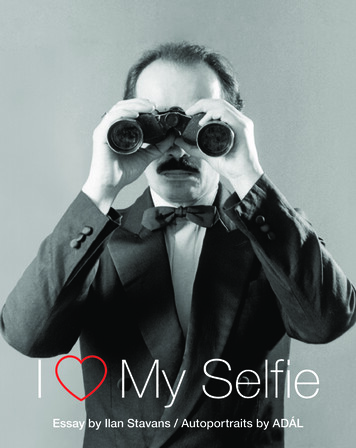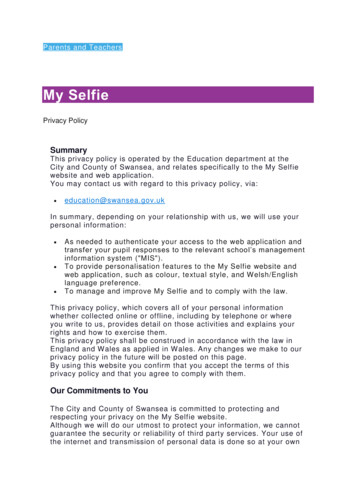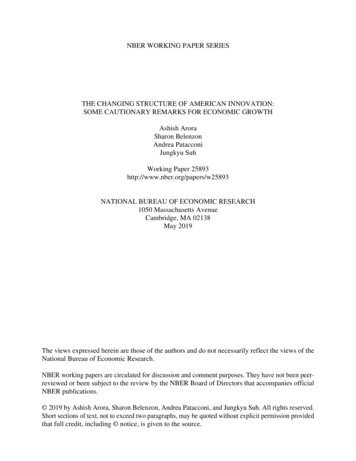
Transcription
IMy SelfieEssay by Ilan Stavans / Autoportraits by ADÁL
B O O K S B Y I L A N S TA VA N SFiction The Disappearance The One- Handed Pianist and Other StoriesNonfiction The Riddle of Cantinflas Dictionary Days On BorrowedWords Spanglish The Hispanic Condition Art and Anger Resurrecting Hebrew * A Critic’s Journey The Inveterate Dreamer Octavio Paz:A Meditation Imagining Columbus Bandido ¡Lotería! (with TeresaVillegas) José Vasconcelos: The Prophet of Race Return to CentroHistórico Singer’s Typewriter and Mine Gabriel García Márquez: TheEarly Years, 1927 – 1970 The United States of Mestizo Reclaiming Travel(with Joshua Ellison) Quixote: The Novel and the World Borges, the JewJudaica The New World HaggadahConversations Knowledge and Censorship (with Verónica Albin) What Is la hispanidad? (with Iván Jaksić) Ilan Stavans: Eight Conversations (with Neal Sokol) With All Thine Heart (with Mordecai Drache) Conversations with Ilan Stavans Love and Language (with VerónicaAlbin) ¡Muy Pop! (with Frederick Aldama) Thirteen Ways of Lookingat Latino Art (with Jorge J. E. Gracia) Laughing Matters (with FrederickAldama)Children’s Book Golemito (with Teresa Villegas)Anthologies The Norton Anthology of Latino Literature TropicalSynagogues The Oxford Book of Latin American Essays The SchockenBook of Modern Sephardic Literature Lengua Fresca (with Harold Augenbraum) Wáchale! The Scroll and the Cross The Oxford Book ofJewish Stories Mutual Impressions Growing Up Latino (with HaroldAugenbraum) The fsg Book of Twentieth- Century Latin American Poetry Oy, Caramba!
Graphic Novels Latino USA (with Lalo Alcaraz) Mr. Spic Goesto Washington (with Roberto Weil) Once @ 9:53 am (with MarceloBrodsky) El Iluminado (with Steve Sheinkin) A Most Imperfect Union(with Lalo Alcaraz)Translations Sentimental Songs, by Felipe Alfau The Plain in Flames,by Juan Rulfo (with Harold Augenbraum) The Underdogs, by MarianoAzuela (with Anna More) Lazarillo de TormesEditions César Vallejo: Spain, Take This Chalice from Me The Poetryof Pablo Neruda Encyclopedia Latina (4 volumes) Pablo Neruda: I Explain a Few Things The Collected Stories of Calvert Casey Isaac BashevisSinger: Collected Stories (3 volumes) Cesar Chavez: An Organizer’s Tale Rubén Darío: Selected Writings Pablo Neruda: All the Odes LatinMusic (2 volumes)General The Essential Ilan StavansBOOKS BY ADÁLPhotography The Evidence of Things Not Seen Portraits of the PuertoRican Experience Mango Mambo Out of Focus Nuyoricans Blueprintsfor a Nation / Jíbaro Falling Eyelids
IMy Selfie
IMy SelfieEssay by Ilan Stavans / Auto-Portraits by ADÁLDuke University Press Durham and London 2017
Essay by Ilan Stavans 2017 DukeUniversity Press. Auto- portraits ADÁL. All rights reserved.Printed in the United States ofAmerica on acid- free paper Designed by Amy Ruth BuchananTypeset in Arno Pro by CopperlineLibrary of Congress Cataloging- in- Publication DataNames: Stavans, Ilan, author. Maldonado, Adâl Alberto, photographer.Title: I love my selfie / essay by IlanStavans ; auto- portraits by Adâl.Description: Durham : Duke UniversityPress, 2017. Includes index.Identifiers: lccn 2016040908 (print)lccn 2016041333 (ebook)isbn 9780822363385 (hardcover : alk.paper)isbn 9780822363491 (pbk. : alk. paper)isbn 9780822373179 (e- book)Subjects: lcsh: Self- portraits — UnitedStates — Exhibitions. Self- presentation —United States — Exhibitions. Photography — United States —Psychological aspects — Exhibitions. Maldonado, Adâl Alberto — Self- portraits — Exhibitions. Social media —United States — Psychological aspects.Classification: lcc n7619.s73 2017 (print) lcc n7619 (ebook) ddc 770.973 — dc23lc record available at https://lccn.loc.gov/2016040908Cover art: Autoportrait. ADÁL, ThePenetration of an Object from a ClosedSpace, 1990.
To John Berger,for teaching me the differencebetweenlooking and seeing . . .And to Miriam Sokoloff.—I. S.
This above all: to thine own self be true,and it must follow, as the night the day,thou canst not then be false to any man.—Hamlet, Act I, Scene 3
Contents1 Chillin’ / 12 The Plight of Narcissus / 103 “Decisive Moments” / 184 Out of Focus / 28Go F ck Your Selfie: A Portfolioadál / 395 Alone with Others / 916 Rembrandt’s Instamatic / 987 Tropic Noir / 1138 And Then Comes Darkness / 122Acknowledgments / 129Index / 131
1CHILLIN’Of the hundreds — nah, thousands! — of cellfies I usually store inmy smartphone, including pictures of family and friends, as well asconsequential places and occasions, a generous percentage is whatI call “false starts.” In these the relation between cause and effect isinverted. Rather than my taking a spontaneous picture of a naturalmoment, I manipulate nature to fit it into a picture. For instance, Ihave an image of a tombstone in a Jewish cemetery near Havana.There is an uneven pile of pebbles on top of it. When visiting agrave, it is a Jewish custom to leave a stone, not flowers, on it asa memento. The reasons, I believe, are manifold. Flowers perishand stones last, symbolizing the permanence of memory; according to the Talmud, a person’s soul lingers on earth for a while afterdeath, and placing a stone is a way to prolong that stay and even toencourage the soul to return; and then there is a semantic explanation: the Hebrew word for “pebble” is tz’ror, which also means“bond.” This verbal link turns the stone placed on the tombstoneinto a bridge between this world and the next.During my visit to Havana, the grave I was compelled to photograph — its structure destroyed by vandals — had beer bottles andother garbage piled up on top. I opted to clean it up and even feltrighteous about it. In doing so, I added, for aesthetic purposes, several extra pebbles forming an irregular structure. Thus, I doctored
nature to my own needs. Of course, there is nothing either new or special aboutthis. In fact, the strategy is as old as photography itself: we don’t use the camerato capture what we see; we invent what we see in order to take a picture. Exceptthat the smartphone camera is, supposedly, a lens through which we capture lifeas is, unadulterated, in the spur of the moment — life uncontrolled by the eye.In and of itself, maybe this anecdote is a false start — mind you, I got rid ofseveral others — to a disquisition like this one on the profound role selfies playin Western civilization in general (whatever that means!) and in American culture in particular (again, if such a thing exists!), and on the oeuvre of Adál, thegroundbreaking Nuyorican artist whose oeuvre, about the search for selfhood,I have admired for decades. After all, I myself don’t show up in the photograph,meaning it is a cellfie but not a selfie, aka a cellphone picture but not a shot ofmyself. Nor is the image especially memorable, at least not to others. I keep itin my photo app as evidence of an enlightening journey to Cuba. I don’t thinkI have shown it to anyone else. Anyway, I like the idea of starting this narrativeattempt, imperfect as it is likely to be, with what is probably a misstep, since mypurpose is to explore both authenticity and dishonesty. Or maybe I should sayit in another way: I want to talk about truth in selfies, aware as I am that it is afutile proposition.I find it curious that we condemn dishonesty at all times on ethical grounds,yet everyone engages in it. That is what hypocrisy is: being duplicitous. Thinkof the famous line Shakespeare gives to Polonius, King Claudius’s chief councillor. Polonius, a single father, advises his son Laertes, who is about to depart forFrance, “This above all: to thine own self be true.” No better fatherly instructionmight be given. Yet Polonius fails to explain how Laertes should be truthful.Should “true” be taken to mean faithful, realistic, practical? Is it synonymouswith moral uprightness? Is “to thine own self be true” the same as “to thy self beauthentic”? And how should Laertes go about finding the road of truth, if sucha road exists?At any rate, the imperative is to be direct, honest, and straightforward. Hamlet is both a reflective and a reflexive play: it meditates on existence as a wholeand also on its own theatricality, on its own existence as a play. The evidenceabounds: for example, Hamlet’s endless ruminations, his agonizing to- be- and- not- to- be (that is the question!), and the insertion of a play within the play inact III, scene 2. It wonders whether we control thoughts or they control us. It2 C H A P T E R O N E
wonders what our role is as witnesses of injustice. And, equally crucial, it investigates the role of art as a tool for change.In Polonius’s statement, an important aspect not yet seized at this point by theaudience is that he himself is a conniver, a kind of Lord Chamberlain. His advice to Laertes is thus ironic, to the point of turning the statement upside down.Polonius the schemer might actually be telling his son to be untrue, to behave inways that are advantageous to him. “This above all: to thine own self be true, andengage in dishonesty if this advances your cause.” This advice will prove useful toLaertes. In other words, to be truthful is to satisfy the needs of the self.Inherently, false starts are dishonest; that is, they are untruthful. Yet thisis the kind of dishonesty everyone practices. My tombstone photo reveals byway of hiding; it delivers a message that looks unplanned but was meticulouslyplanned. The image it offers is a disguise, a façade, a front. Were I to circulateCeci n’est pas une pipe, no one, I assume, would complain that it was counterfeit.Honestly, I myself am not conflicted about my photo’s fakeness. I’m happy because I took the picture I wanted to take. It is false, sure, but so is life as a whole.A false start isn’t a defeat; it is simply another way to engage the world. In hislucid essay “Of Cannibals,” Montaigne says that there are defeats more triumphant than victories. I for one see these false starts on my smartphone’s cellfiemuseum as statements of purpose: they are snapshots of reality as I want realityto be.Late in 2015, I discovered a red spot in my upper left cheek, almost undermy eye. I thought it would disappear on its own but it didn’t. I consulted adoctor, who told me it was a basal cell carcinoma, a mild case of skin cancer,and it needed to be removed. The surgery was painful: a two- inch incision,sealed with nineteen stitches. The wound took a couple of weeks to heal andseveral months to integrate itself to the landscape of my face. Early on, whenever I would look at myself in the mirror, I would feel like a pirate: my face wasstrange, different. The photos I would saw of myself contained something false,an aspect of me I needed to update, to reappraise, to appropriate. Building anew self- image took time and stamina. In retrospect, my situation was smallpotatoes compared with more invasive, long- lasting cancers. Yet the effort atreassessing my self- image, the face I had known and the face I now had, wasnonetheless traumatic. I learned to love the scar. It is true that there are defeatsmore triumphant than victories.C H I L L I N ’ 3
Now think of the errors called parapraxis, commonly known as Freudianslips. These gaffes are more than mere failures of concentration; they are perceived as linguistic faux pas. Psychoanalysts love them (everyone else is horrified!) because they are a window into the unconscious, a way to seize on theself while it is vulnerable and unguarded. Freudian slips are also snippets ofthe self when it isn’t fully in control, a vintage way of understanding that beyondthe façade of restraint we project lurk other intangible forces. These bloopersoffer a fascinating opportunity to explore the relationship between what is concrete with what is secret in our life, between the lies the self tells itself and othersin order to enhance its credibility and the lies it keeps from itself — the part thatis beyond the self ’s reach. The reverse of a Freudian slip might be a lapse inwhich a person suddenly forgets a word; here it is not that unwelcome information has surfaced but that needed information has been scrapped. A hairdresserfriend of mine calls these hiatuses “brain farts.” The difference between a Freudian slip and a brain fart is that one reveals, whereas the other conceals.What these practices show is that the self is an inefficient, ineffective manager, that certain forces are beyond its domain, and that it likes to parade itselfas strong, morally upright, and authentic when in fact its rule depends on deceit.Samuel Beckett, in Worstward Ho, says: “Ever tried. Ever failed. No matter. Tryagain. Fail again. Fail better.”The term selfie (occasionally spelled selfy) is said to have originated in 2002,in an Australian online forum. Since then the frequency with which it is usedworldwide has increased exponentially, in part because other languages (Spanish, French, German, Portuguese, Russian, Hebrew, Arabic . . . ) have incorporated it as their own, occasionally as a derisive artifact that satirizes “the American way of life.” There is something of a Hallmark card in the sound of the term:be selfless in a selfie; that is, be free and let others know. Or, paraphrasing OscarWilde, be yourself in a selfie because everyone else is already taken.Selfies, hence, are approximations of the self. They are a business card foran emotionally attuned world. They promise smiles, happiness, and engagement. In delivering these ingredients, they shape mass taste. Selfies can’t staystill; they need to be constantly disseminated, navigating the globe, posted allover for others to endorse with a two- thumbs- up. A selfie taken but stored isn’tthe real thing; a real selfie needs to be distributed through social media. Voyeursbecome consumers. The media functions as an educated eye, distinguishing be4 C H A P T E R O N E
tween average selfies (paraded in Instagram, Facebook, Twitter, and Snapchat,for instance) and high- brow selfies (Tumblr).This ecosystem allows them to be in a popularity contest. People like irreverence, sarcasm; they dislike snobbism, pedantry, aloofness. Certain topics become taboo. For instance, I have seen a selfie taken next to a corpse and foundit nauseating. (It never crossed my mind, in the Havana cemetery, to take a selfiewith the gorgeous tombstone in the background. Taking such a photo wouldprobably have been more irreverent than my irreverent act of cleaning up thegrave.) Likewise, I don’t often come across selfies taken in a state of depression.Or featuring blood, although I once watched a smartphone video, posted by theNew York Times, of a bunch of Arab terrorists who had captured a large boat.They were doing rounds shooting at escapees swimming away in the ocean.One of the shots hits its target, and blood colors the area where the victim was.The terrorists laugh, then congregate triumphantly to take a selfie near the prow.And I have also seen a selfie with blood whose purpose was to serve as evidencefor the police, as proof that a fight between two neighbors had taken place.The reason violent selfies are uncommon is that these aren’t aspects of existence people want to share with others; on the contrary, they would rather keepthese facets to themselves. For, in the end, the selfie is a portal through whichwe share the handsomest, least frightening side of our self. The word “fright”isn’t part of the selfie lexicon.Selfies are about catching ourselves halfway, in the act — and art — of living,moving around casually, being informal, laid- back, blasé, doing nothing but, touse today’s slang, “chillin’.” Or else, about being a trickster, a fool, maybe evena dissenter. As a selfie I once got stated it, “I’d rather laugh with the sinners.”In the selfie, the mandate is to look impeccably cool in our unawareness, tobe in flagrante delicto without a crime even taking place. “Funny you mentionthat — I was just thinking I don’t care,” reads the caption. In selfies I take of myself, for instance, I pretend to be obese. Or my face is divided in the mirror. OrI’m in the Plaza de la Revolución, in Havana, Cuba, with a wall- size drawing ofCamilo Cienfuegos, a leader in Fidel Castro’s uprising, behind me. This is meand isn’t — it’s an impostor, a pretender.Needless to say, this state of blissfulness isn’t achieved easily. The photographer — the selfie taker — must work hard at it. Exiling pain isn’t enough. Beingcalm, composed, and level- headed, being normal, isn’t enough; one must hideC H I L L I N ’ 5
Ilan Stavans, Selfie #31 (Lite), Amherst,Massachusetts, 2015. Photo by author.Ilan Stavans, Selfie #27 (Divided), Amherst,Massachusetts, 2015. Photo by author.Ilan Stavans, Selfie #18 (with Camilo),Havana, Cuba, 2015. Photo by author.
any displacement, any sense of confusion. And, if possible, one must give theimpression that the selfie is a product of a disinterested eye. My son Isaiah wasonce at a Cuban restaurant. A prominent jazz musician (my son called him “theCuban Gaucho”) was sitting behind him. My son didn’t want to attract the musician’s attention, yet he wanted proof that he had been near him. So he took aphotograph of himself in such a way that the musician in the background couldbe clearly spotted. This was only a selfie out of necessity: he wasn’t intent ongetting a photo of himself, but no other social act would have satisfied his needof capturing the jazz musician’s face. This strategy tries to make the selfie blendinto the environment. Yet that disinterest is defined by a tunnel vision.In short, the selfie is performance achieved through overstatement. It is ashow- and- tell game in which secrets are supposedly revealed, made public foreveryone to savor them. In the selfie, we all become normal, ordinary dwellersin the quandary of self- absorption. Samuel Johnson argued that the narcissistdoesn’t hide his faults from himself, but persuades himself that they escape thenotice of others. The selfie does the exact same. It isn’t about the person — it’sabout the persona, a word derived from the Latin term for mask. The self, apparently, is made of multiple masks, which is the way it projects itself to theworld. For our self isn’t a unity but a multiplicity. Thus, as the night follows theday, being true to one’s self means being fundamentally adaptable, contingent,provisional, all of which are attributes of falseness.The selfie blurs the line between the domestic and the communal, betweenwhat is mine and what belongs to others. It goes without saying that photography was always about blurring that line, but the selfie has taken the approach astep further. Mick Jagger was once sitting at a table next to mine at a Manhattanrestaurant. This anecdote isn’t like the one of my son Isaiah with “the CubanGaucho.” I didn’t recognize Jagger. Or maybe I didn’t care who he was. Frankly, Ihave never been interested in the rock music scene as much as I am in Latin jazz.Be that as it may, our tables were contiguous. It was a time before smartphonesbut not before paparazzi. After dinner, the waiter asked Jagger if he could take apicture with him. Jagger demurred. Tonight he wasn’t a rock star, he said. Tonighthe was a private citizen. The waiter politely objected, but he ultimately complied.Were the incident to occur now, perhaps the waiter, despite Jagger’s resistance,would have sat next to him at the table and turned the camera on himself next toC H I L L I N ’ 7
the celebrity. Politeness is no longer a requirement. Having the selfie is an end initself, an expression of love that is worth the effort no matter the expense.All emotions are volatile, therein their disposition, but love, for some reason,seems more elusive, more ethereal than others. It is often hard to pin down. Wedepend on love to thrive. Spinoza, in The Ethics, argued that love, as an emotion,is simply joy accompanied by the awareness of an external cause. For him, emotion is a change in the state of our physical organism to a greater or lesser degreeof vitality, along with an idea, or mental representation, of that change. Selfiesseek to make that love concrete, to make it tangible. Since selfies cannot conveyspirituality in abstract terms, the images included in them must always be obvious, even clichéd. The more extreme those images — the more unreal — themore effectively they transmit their message. I am awed by that love, the wayselfies promote it, the goodwill they disseminate.It is a dangerous type of love, though. (But isn’t love always dangerous?)Although the capacity to produce selfies makes us all equal, creating a made- upcommunity of supposedly happy, interconnected communities, the true talebehind it is about uniformity, homogeneousness, and exclusion. Selfies serveas glue for specific groups, ratifying their intrinsic bonds. Those that are in arepictured in it or else receive it through social media, and those that are out areexcluded, ignored, and silenced. The turf is quite concrete: either you’re myfriend or you hate me. Thus, the selfie reaches only a small base of qualifiedsupporters made of people who pledge allegiance to the selfie taker and whoare thus ready to believe in the fiction portrayed in the selfie. Caption: “Thequestion isn’t ‘Can you?,’ it’s ‘Will you?’ ”In other words, this is about who is hip and who isn’t. The in- crowd uses theselfie to delineate its territory, to specify its confines, and thus to exclude thosealien to it. The out- crowd, by definition, is the one left beyond the margins, theone who isn’t accepted, the one described as uncool. The in- crowd depends onthe selfie to project stability, continuity, and power. Their ultimate, tyrannicalmessage is that normalcy is the right way and anything else is unacceptable. Narcissus is at the center of the orbit, a gravitational force keeping everyone at arm’sreach. Self- love mutates into communal love: Narcissus realizes that because heloves himself, others love him as well.It is rather easy to discredit selfies as manifestations of youthful egotism.They are artifacts of young and old, rich and poor, men and women. They are8 C H A P T E R O N E
like comfort food: easy, fast, and mindless. We are all selfie makers and selfiecritics. When you see a group of tourists with selfie sticks making their waythrough a historic site (say, to invoke “dark tourism,” where the atomic bomblanded in Hiroshima), you are looking at the compulsion not only to frame sightbut also to boast about it, to be in place and displaced at the same time. Andthen, suddenly, you realize yourself are in a selfie.Fine advice, Polonius: to thine own selfie be true! In homage to the minimalistic logo created by Milton Glaser in 1977, pro bono, to promote tourism toNew York, let us all sing cheerfully in unison: I My Selfie. (How do you singan emoticon?)C H I L L I N ’ 9
meaning it is a cellfie but not a selfie, aka a cellphone picture but not a shot of myself. Nor is the image especially memorable, at least not to others. I keep it in my photo app as evidence of an enlightening journey to Cuba. I don't think I have shown it to anyone else. Anyway, I like the idea of starting this narrative










